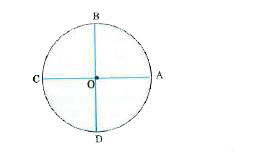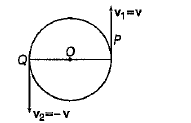A particle is moving in a circle of diameter 5m. Calculate the distance covered and the displacement when it completes 3 revolutions.
The correct Answer is:15π metre ; zero
Step-by-Step Solution:
Step 1: Understand the problem and given data.
- Diameter of the circle, D=5 meters.
- Number of revolutions, n=3.
Step 2: Calculate the distance covered.
The distance covered by the particle is the total length of the path it travels. Since the particle is moving in a circle, the distance covered in one revolution is the circumference of the circle.
- The formula for the circumference of a circle is:
Circumference=π×D
where D is the diameter of the circle.
- For one revolution:
Circumference=π×5 meters
- For three revolutions:
Distance covered=3×π×5 meters
- Simplify the expression:
Distance covered=15π meters
- Approximate the value using π≈3.14:
Distance covered=15×3.14 meters≈47.1 meters
Step 3: Calculate the displacement.
Displacement is the shortest distance between the initial and final positions of the particle. Since the particle completes 3 revolutions and returns to its starting point, the initial and final positions are the same.
- Therefore, the displacement is:
Displacement=0 meters
Final Answer:
- Distance covered: 47.1 meters (approximately).
- Displacement: 0 meters.
- Number of revolutions, n=3.
Circumference=π×D
where D is the diameter of the circle.
Circumference=π×5 meters
Distance covered=3×π×5 meters
Distance covered=15π meters
Distance covered=15×3.14 meters≈47.1 meters
Displacement=0 meters
- Displacement: 0 meters.
Topper's Solved these Questions
- MOTIONBOOK - PRADEEPCHAPTER - MOTIONEXERCISE - Oral testing
19 Videos
- MOTIONBOOK - PRADEEPCHAPTER - MOTIONEXERCISE - Quiz testing
12 Videos
- MOTIONBOOK - PRADEEPCHAPTER - MOTIONEXERCISE - value based question
4 Videos
- GRAVITATIONBOOK - PRADEEPCHAPTER - GRAVITATIONEXERCISE - Model Test paper (1)
36 Videos
- SOUNDBOOK - PRADEEPCHAPTER - SOUNDEXERCISE - Model Test (sec - B)
12 Videos
Similar Questions
A body is moving along a circular path of radius R. What will be the distance travelled and displacement of the body when it completes half a revolution ?
View SolutionA particle is moving in anticlockwise direction along a circle of radius R.

Calculate the distance and displacement covered by the particle (i) from A to C (ii) from A to D.
View Solution
Knowledge Check
A particle is moving in a circle of diameter 10m. The distance covered by it on completing 2 revolutions is
A40mB20mC20πmDzeroA particle moves 3m north , then 4m east and finally 6m south . Calculate the distance travelled and the displacement.
A12 m, 7 mB13 m, 5 mC13 m, 13 mDNone of theseAn object is moving in a circle of radius r. Calculate the displacement when it completes one full circle.
A2πrB4πrCzeroDπ/2
An athlete complete one round of a circular track of diameter 200m in 40s. What will be the distance covered and the displacement at the end of 2 minutes ?
View SolutionAn athlete complete one round of a circular track of diameter 200m in 40s. What will be the distance covered and the displacement at the end of 2 minutes 20s ?
View SolutionIf a body is moving withuniform speed of 10m/s on a circular path of diameter 2 m , then the difference between the distance covered by it and displacement un half revolution will be
View SolutionA particle moves along a circular path of radius R. The distance and displacement of a particle after one completer revolution is
View SolutionA particle is moving with a constant speed in a circular orbit. Find the change in its velocity when it completes half the revolution.

View Solution
